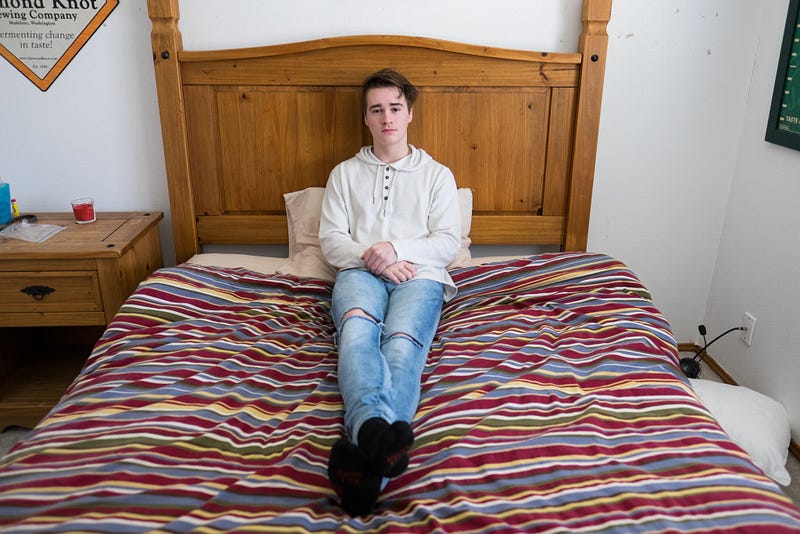Always Dreaming
High school senior balances school, work and living with narcolepsy
STORY BY MADELINE MOHN | PHOTOS BY JAKE TULL
He’s not really sure how much sleep he got last night. The late morning light that seeps into his bedroom sometimes confuses his sense of time and worsens his hallucinations. His neck is sore from sleeping on it wrong and the house is quiet. He doesn’t want to get up. But after a few minutes, Braden Hansen opens his eyes.
Braden, an 18-year-old high school senior from Mukilteo, Wash., was diagnosed with narcolepsy last year.
Narcolepsy affects more than 200,000 people in the United States. It is a neurological disorder caused by the brain’s inability to regulate the body’s normal sleep cycle. People with the disorder may suffer from fatigue, sleep paralysis, insomnia and sleep attacks. It is estimated that less than a quarter of cases are diagnosed.
According to the National Health Service, many cases of narcolepsy are caused by a lack of the chemical orexin, which regulates sleep. Some patients inherit a genetic orexin deficiency, but many cases are caused by major psychological trauma, hormone changes or head injuries.
Braden’s narcolepsy is the result of the latter; he estimates that he’s suffered four concussions playing baseball and football.
Braden says it’s not at all unusual. American athletes between the ages of 14 and 18 suffer thousands of concussions every year, according to Nationwide Children’s Hospital, usually from playing football, hockey and soccer. He has many friends and teammates who have suffered concussions playing sports, but not all of them receive proper care and diagnosis.
“I got knocked out cold playing baseball as a kid,” he says. “They brushed me off and I sat on the bench for a few innings, but since I felt fine and wanted to play, they eventually put me back in.”
He says sports medicine and policy has changed in the six years since he was in Little League. Coaches and parents are more careful than they used to be, and Braden thinks this is a good thing.
He hasn’t played any school sports since his diagnosis, but would if his work schedule permitted him time.
Braden has lived a lot in 18 years. He’s worked at a local pizza joint, in private construction, in an automotive shop, for a fantasy sports company, and now at a day care. He gets good grades, mostly A’s and B’s and drives a bright blue Jeep Wrangler.

Lean, tall and fearless, he’s a natural athlete and his interests are as numerous as his talents — in the last year alone he’s taught himself photography, piano, fashion design, improv and how to drive stick shift.
Still deciding between the University of Washington Bothell, Washington State University and Everett Community College, Braden plans to pursue firefighting or emergency medicine as a career.
“Helping people is important to me,” he says. “I can’t see myself doing anything else, really.”
When Braden tells people about his condition, he often gets remarks about the disorder being unusual in people his age. It’s true that narcolepsy is rarely diagnosed in teenagers, because the early symptoms of fatigue and insomnia are so common in high school students. Unless symptoms are severe, diagnoses are not usually determined until seven years after onset.
But Braden isn’t tired like other students are tired; he’s exhausted all the time, and to a troublesome degree.
Some patients manage the disorder by changing their behaviors. Taking short naps during the day can reduce fatigue; avoiding alcohol, caffeine and nicotine can help minimize symptoms. Braden adheres to all these recommendations but one — caffeine is the only thing that gets him through the day.
Braden’s condition qualifies him for a 504 plan, an academic accommodation program for students with unique healthcare needs, which allows him more time to work on his assignments.
Tricia Profitt, Braden’s mother, says he sleeps a lot.
Braden says even when he appears to be sleeping, he is sometimes conscious. During sleep paralysis, which happens when he’s falling asleep or waking up, Braden can’t move or speak and often faces hallucinations. Sleep paralysis was the chief symptom that led his doctor to a diagnosis. Braden says it’s also the symptom that scares him the most.

The hallucinations are frightening and intense. He sometimes sees a malevolent presence, an intruder who walks into his bedroom and watches him struggle to regain control of his body.
Tricia worried about Braden telling the doctor about his hallucinations, fearing he would think the same thing.
“When he first started talking about seeing a man in his room, I thought he sounded crazy,” she says. “But as soon as Braden described what he was seeing, the doctor said, ‘I know what’s wrong. You have narcolepsy.’”
At its worst, his sleep paralysis occurred two or three times a week.
“It’s better now,” Braden says. “And it’s honestly a relief to know that it comes from my condition. Otherwise I would think I was going insane.”
With the support of his family and friends, Braden has been able to pursue his many aspirations like any normal high schooler.
There is no widely-accepted cure for narcolepsy. In fact, Braden’s symptoms will only get worse over time, Tricia says.
“There’s nothing I can do about it,” Braden says. His tone isn’t resentful or despondent; he states it like a fact. “I know I can succeed regardless.”
It’s late and Braden sits blinking in front of the downstairs TV. His dad is snoring and his mom’s face is illuminated by her phone screen in the darkness.
Sleep takes him easily on the couch. But he knows if he gets up to move to his room, sleep won’t seem so simple. He knows he might lie awake for a while. He knows falling asleep sometimes means falling into a trap. But Braden gets up from the couch, kisses his mother and goes to bed.
